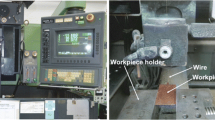Abstract
Experimental work shows the effects of positive-stress ratios, or tensile-minimum stress during the fatigue cycle on the fatigue-crack initiation from holes. This simulates the effect of the residual-tensile stresses at the outside surface of autofrettaged cylinders. S-N curves and modified Goodman diagrams are shown for fatigue-crack initiation.
Similar content being viewed by others
Abbreviations
- a :
-
inside radius of cylinder
- (a) :
-
approximate hole diameter in bend specimens
- b :
-
outside radius of cylinder
- h :
-
thickness of bend specimens
- I :
-
logarithmic value ofy-intercept from S-N curve
- N i :
-
number of cycles for fatigue-crack initiation
- K f :
-
fatigue-strength-reduction factor
- K t :
-
stress-concentration factor
- K t∞ :
-
stress-concentration factor for infinite-width plate
- p :
-
internal pressure on cylinder
- R :
-
stress ratio between minimum stress and maximum stress
- r :
-
any radius between the inside and outside radius of cylinder
- S :
-
slope of S-N curve
- W :
-
cylindrical-wall ratio between outside and inside diameter
- \(\sigma _{alt} \) :
-
alternating stress
- \(\bar \sigma _{alt} \) :
-
alternating stress × the fatigue-strength-reduction factorK f
- \(\sigma _{max} \) :
-
maximum stress
- \(\bar \sigma _{max} \) :
-
maximum stress × the fatigue-strength-reduction factorK f
- \(\sigma _{mean} \) :
-
mean stress
- \(\bar \sigma _{mean} \) :
-
mean stress × the fatigue-strength-reduction factorK f
- \(\sigma _{min} \) :
-
minimum stress
- \(\bar \sigma _{min} \) :
-
minimum stress×the fatigue-strength-reduction factorK f
- \(\sigma _{t^R } \) :
-
tangential-residual stress resulting from overstrain or autofrettage
- \(\sigma _{t^P } \) :
-
tangential stress resulting from internal pressurization
- \(\sigma _Y \) :
-
yield strength of material
References
Davidson, T.E., Kendall, D.P. and Reiner, A.N., “Residual Stresses in Thick-walled Cylinders Resulting From Mechanically Induced Overstrain,” Experimental Mechanics,3 (11), (Nov. 1963).
Richards, C.W., Engineering Materials Science, Wadsworth Publishing Company, Inc., Belmont, CA (1967).
Peterson, R.E., Stress Concentration, Factors, John Wiley and Sons, NY (1974).
Lipson, C. andSheth, N.J., Statistical Design and Analysis of Engineering Experiments, McGraw-Hill Book Company, NY (1973).
Burk, J.D. andLawrence, F.V., “The Effect of Residual Stresses on Weld Fatigue Life,”Fract. Control Program Rep. No. 29, College of Engineering, University of Illinois, Urbana, IL (Jan.1978).
Author information
Authors and Affiliations
Rights and permissions
About this article
Cite this article
Fujczak, R.R. Effects ofR-ratio on crack initiation at external discontinuities in autofrettaged cylinders. Experimental Mechanics 24, 122–128 (1984). https://doi.org/10.1007/BF02324994
Received:
Revised:
Issue Date:
DOI: https://doi.org/10.1007/BF02324994



